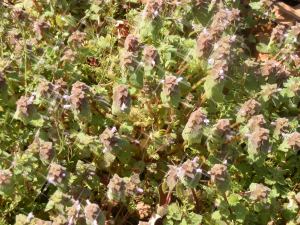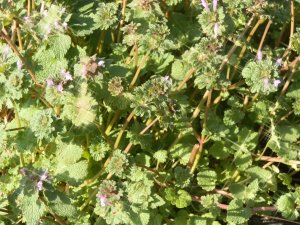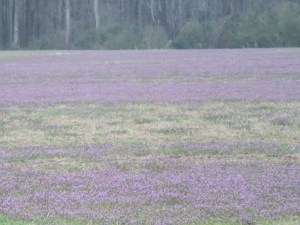Look around in our soon to be planted fields and you’ll see a mass of pink to purple. The two likely culprits are henbit (Lamium amplexicaule) and dead nettle (Lamium purpurea). Both are exotic invaders from the mint family and both are edible with medicinal uses.
Henbit is more of a loose runner. Its square stems are thinner. Heart-shaped leaves with rounded teeth clasp the stem. They have no little stem (petiole) between the main stem and leaf blade. Amplexicaule is Latin for clasping. Abundant flowers tend to be pink. Dead nettle flowers usually display more purple.
Purple dead nettle grows more upright and a petiole connects the blade to the main stem, which is usually thicker than those on henbit. Plants can get over a foot tall. Leaves are roughly triangular and become purplish and smaller near the stem tips. Dead nettle gets its name because the hairs on the stem will not sting you like true nettles will.
Being mints, both of these Lamiums reproduce profusely by seeds, each plant capable of producing several thousand. Henbit also spreads and gains vigor when stems root to the ground, much like crabgrass does. Both can depress yields of wheat and other cool-weather crops. They can crowd a young stand of row crops and carry disease-causing nematodes and fungi. These mints also contain chemicals that inhibit the growth of other plants.
Most broad-leaf weed killers will knock both out of lawns. This time of year there is very little risk of turf injury to warm-season grasses like Bermuda, St. Augustine, and centipede, since they are dormant. Both henbit and dead nettle will colonize bare spots quickly when grass is dormant.
By the time your turf greens up though, these two species will likely be gone. Warm weather is not their friend. They don’t thrive when temperatures increase and they become very susceptible to powdery mildew, which usually finishes them off. Unfortunately, before they disappear they further inoculate the area with that fungus.
Another control solution could be to let chickens graze the area. They love it, but this is probably not practical. Hummingbirds sample their flowers on warm early spring days too, but with no harm to the plants.
If you can harvest these mild mints before the leaves are covered with dusty white mold they are quite palatable and nutritious. I prefer them cooked with a little salt and butter, but some people eat them raw in salads. Seeds are extremely high in antioxidants and the leaves are rich in fiber and vitamins. Foliage has diuretic properties and increases sweating and urine flow. Like the plantains, dead nettle and henbit also diminish bleeding. Extracts and teas are used for menstrual problems.
They also show promise as anti-inflammatories and pain reducers. Purple dead nettle works by interfering with the release of the hormone prostaglandin-2. Dead nettle contains chemicals called sterols, which among other things help treat enlarged prostates. It appears they can be good for men and women.
Ted Manzer teaches agriculture at Northeastern High School.





How timely! I was just trying to identify one of these plants this afternoon! Though I’m still a little confused. The plant I’m trying to identify looks like you describe henbit (for example, no petioles–the leaves definitely grasp the stem), except that its flowers are definitely purple, not pink. Is there a purple variety of this? One that could have colonized my entire yard?
Flower color can vary a lot. Some of it is orchid to purple. The ground ivy is purple too, but it has petioles and is usually a little later in the spring.
Thanks! The more pictures of these plants I see, the more obvious it is that I’m looking at henbit (since the top leaves have no petioles, and the leaves are round, not triangular). Thanks for your great blog!
Tons of henbit around here – although I’ll never convince my husband it isn’t chocolate mint, for some reason – and the flowers are deep purple.
Thanks for the info on using it, since I’ll never be able to get rid of it!
This plant sounds like its good, i’ve seen these quite a bit just never knew anything of them
See these all the time, they look terrible in yards, but i did not know they were classified as mints.
Grateful for sharring this
It’s surprising to me that these are actually being selectively bred for ornamental use.